Entry Program Case Study: CKD and Hypertension Clinical Reasoning
VerifiedAdded on 2022/10/17
|9
|2308
|22
Case Study
AI Summary
This case study examines the case of George, a 51-year-old Aboriginal and Torres Strait Islander male with CKD and hypertension, applying the clinical reasoning cycle to his care. The assignment details the steps involved, including considering the patient's background, collecting cues and information (vital signs, medical history, medications), processing the information (interpretation, discrimination, relation, inference, matching situations, and predicting outcomes), taking action (recommending ACE inhibitors and ARBs), and reflecting on the process. George's history includes a stroke, diabetes, and smoking, which contributed to his worsening health, including increased weight, elevated blood pressure, and reduced kidney function. The study emphasizes the importance of understanding the medications prescribed (perindopril, furosemide, atorvastatin, metformin, sodium bicarbonate, and vitamin D), and the need for patient education and support. The clinical reasoning cycle is used to analyze George's condition, propose interventions, and highlight the importance of monitoring his progress and encouraging lifestyle changes to manage his hypertension and CKD effectively. The study aims to improve clinical reasoning skills for nursing students, enabling them to provide effective patient care and management.
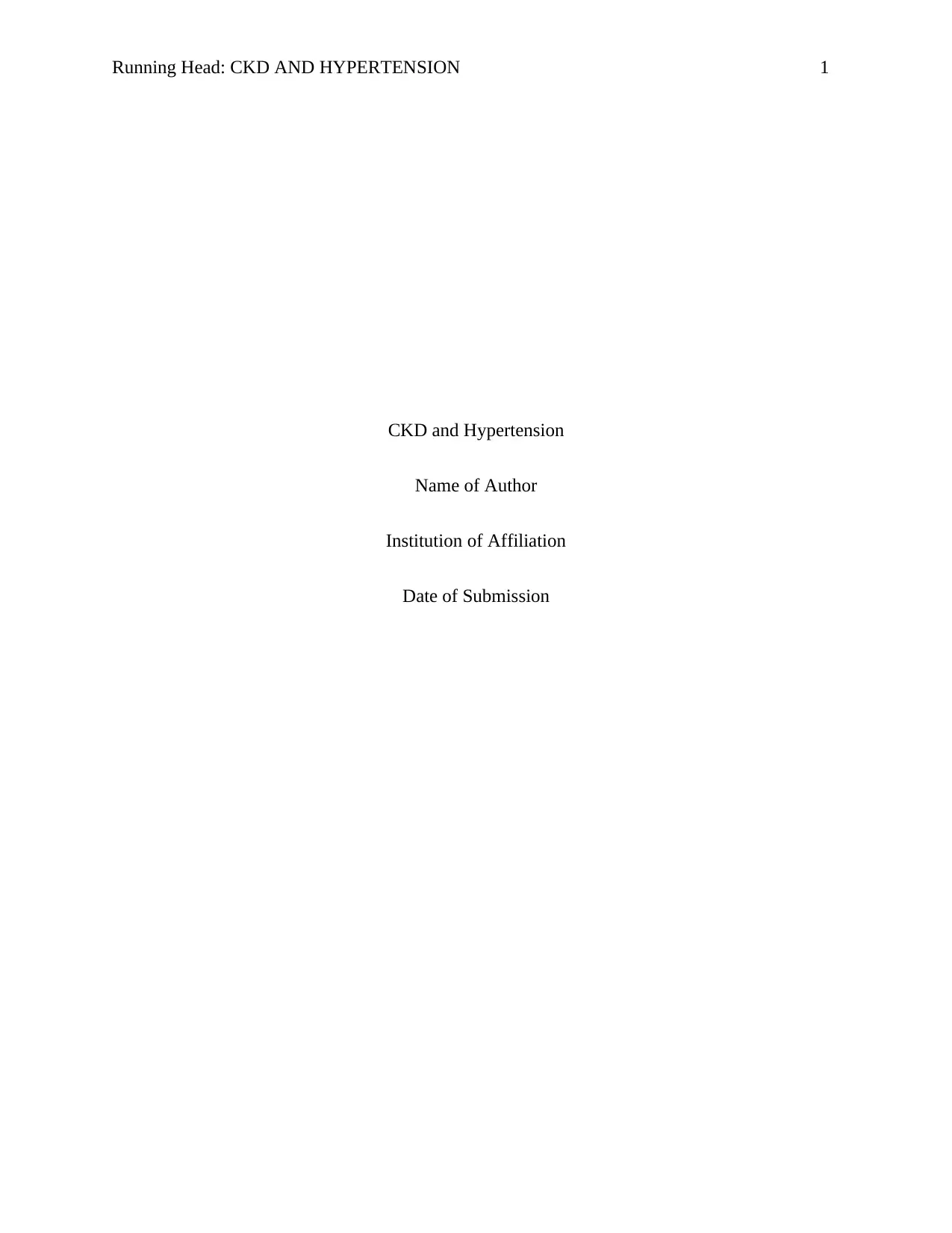
Running Head: CKD AND HYPERTENSION 1
CKD and Hypertension
Name of Author
Institution of Affiliation
Date of Submission
CKD and Hypertension
Name of Author
Institution of Affiliation
Date of Submission
Paraphrase This Document
Need a fresh take? Get an instant paraphrase of this document with our AI Paraphraser
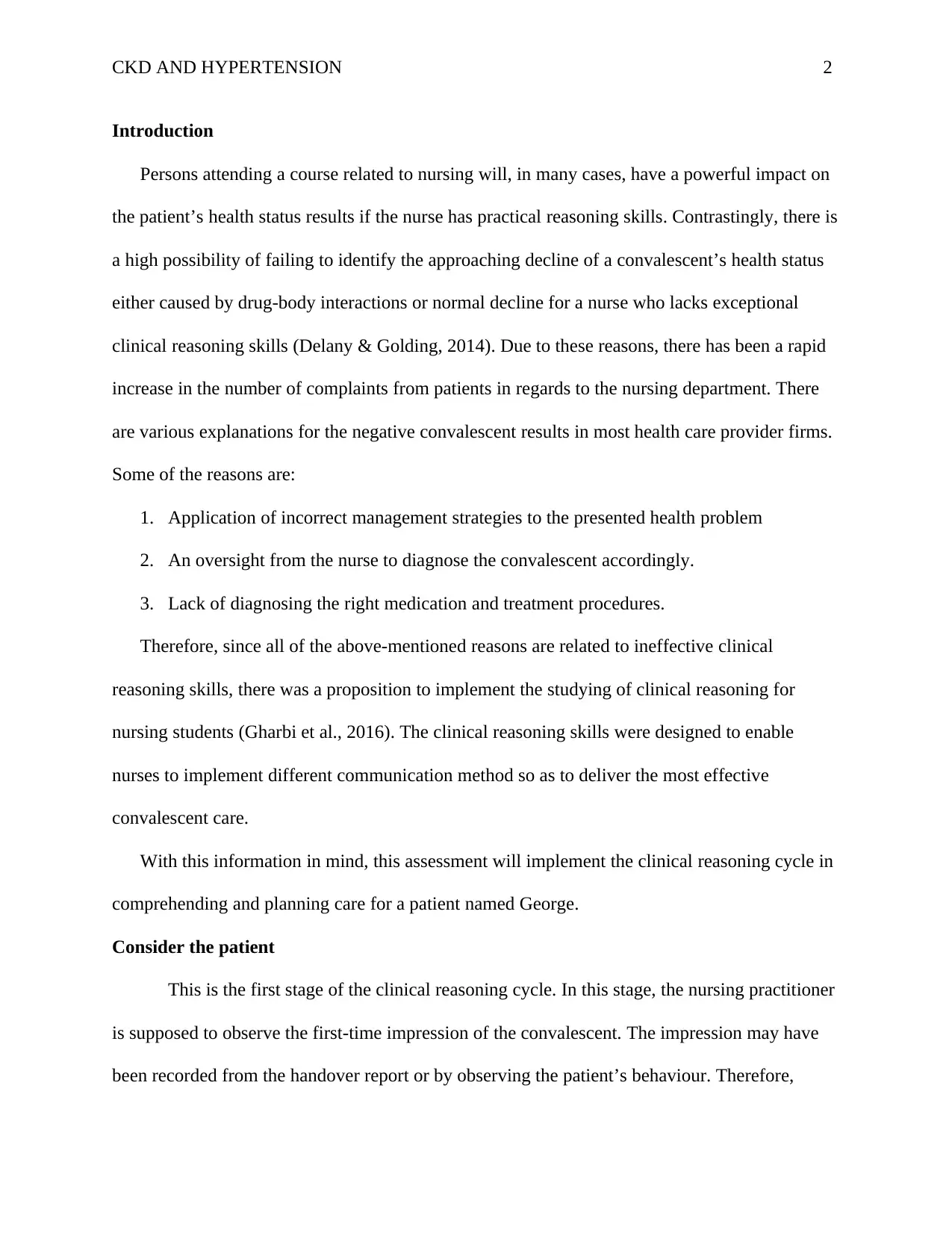
CKD AND HYPERTENSION 2
Introduction
Persons attending a course related to nursing will, in many cases, have a powerful impact on
the patient’s health status results if the nurse has practical reasoning skills. Contrastingly, there is
a high possibility of failing to identify the approaching decline of a convalescent’s health status
either caused by drug-body interactions or normal decline for a nurse who lacks exceptional
clinical reasoning skills (Delany & Golding, 2014). Due to these reasons, there has been a rapid
increase in the number of complaints from patients in regards to the nursing department. There
are various explanations for the negative convalescent results in most health care provider firms.
Some of the reasons are:
1. Application of incorrect management strategies to the presented health problem
2. An oversight from the nurse to diagnose the convalescent accordingly.
3. Lack of diagnosing the right medication and treatment procedures.
Therefore, since all of the above-mentioned reasons are related to ineffective clinical
reasoning skills, there was a proposition to implement the studying of clinical reasoning for
nursing students (Gharbi et al., 2016). The clinical reasoning skills were designed to enable
nurses to implement different communication method so as to deliver the most effective
convalescent care.
With this information in mind, this assessment will implement the clinical reasoning cycle in
comprehending and planning care for a patient named George.
Consider the patient
This is the first stage of the clinical reasoning cycle. In this stage, the nursing practitioner
is supposed to observe the first-time impression of the convalescent. The impression may have
been recorded from the handover report or by observing the patient’s behaviour. Therefore,
Introduction
Persons attending a course related to nursing will, in many cases, have a powerful impact on
the patient’s health status results if the nurse has practical reasoning skills. Contrastingly, there is
a high possibility of failing to identify the approaching decline of a convalescent’s health status
either caused by drug-body interactions or normal decline for a nurse who lacks exceptional
clinical reasoning skills (Delany & Golding, 2014). Due to these reasons, there has been a rapid
increase in the number of complaints from patients in regards to the nursing department. There
are various explanations for the negative convalescent results in most health care provider firms.
Some of the reasons are:
1. Application of incorrect management strategies to the presented health problem
2. An oversight from the nurse to diagnose the convalescent accordingly.
3. Lack of diagnosing the right medication and treatment procedures.
Therefore, since all of the above-mentioned reasons are related to ineffective clinical
reasoning skills, there was a proposition to implement the studying of clinical reasoning for
nursing students (Gharbi et al., 2016). The clinical reasoning skills were designed to enable
nurses to implement different communication method so as to deliver the most effective
convalescent care.
With this information in mind, this assessment will implement the clinical reasoning cycle in
comprehending and planning care for a patient named George.
Consider the patient
This is the first stage of the clinical reasoning cycle. In this stage, the nursing practitioner
is supposed to observe the first-time impression of the convalescent. The impression may have
been recorded from the handover report or by observing the patient’s behaviour. Therefore,
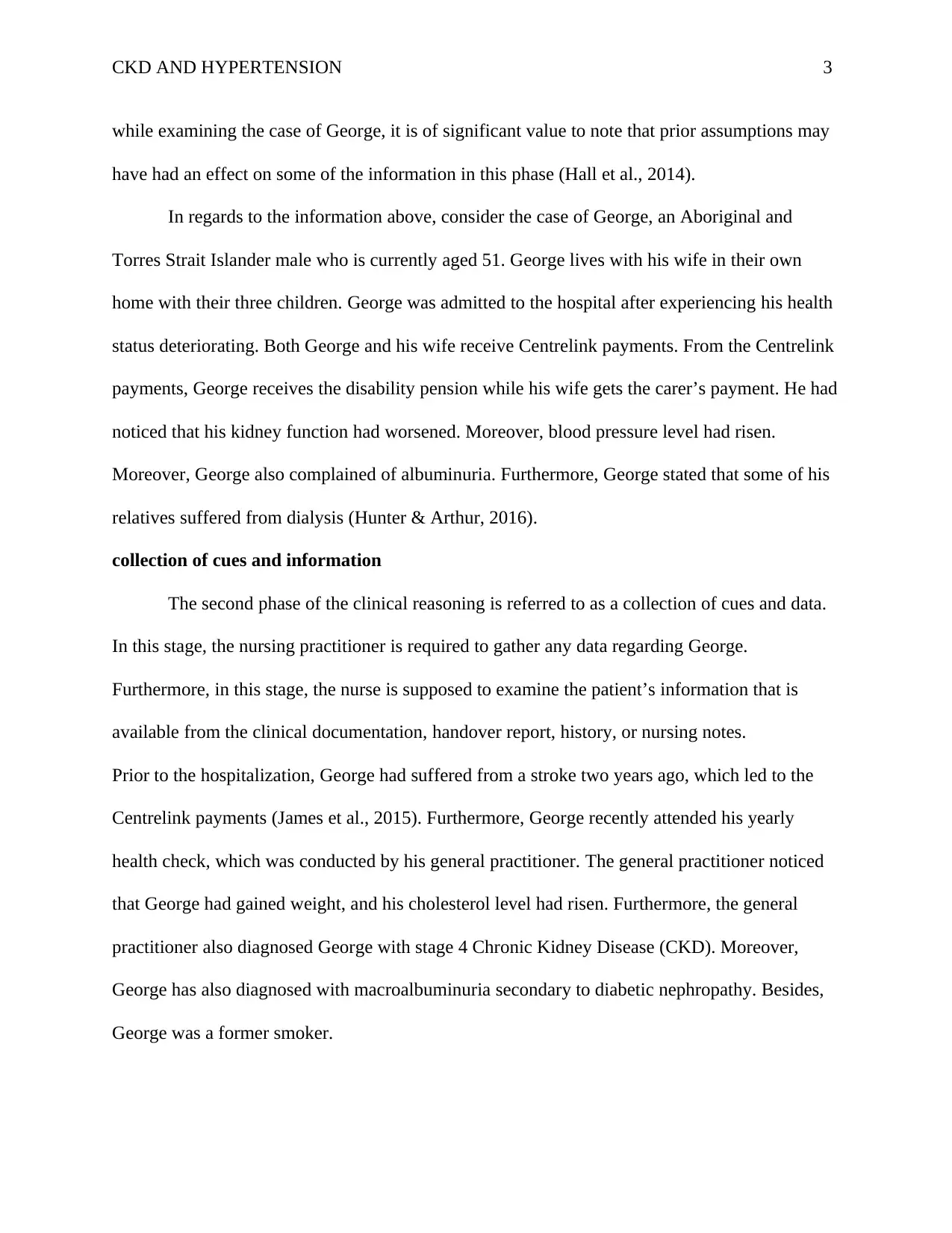
CKD AND HYPERTENSION 3
while examining the case of George, it is of significant value to note that prior assumptions may
have had an effect on some of the information in this phase (Hall et al., 2014).
In regards to the information above, consider the case of George, an Aboriginal and
Torres Strait Islander male who is currently aged 51. George lives with his wife in their own
home with their three children. George was admitted to the hospital after experiencing his health
status deteriorating. Both George and his wife receive Centrelink payments. From the Centrelink
payments, George receives the disability pension while his wife gets the carer’s payment. He had
noticed that his kidney function had worsened. Moreover, blood pressure level had risen.
Moreover, George also complained of albuminuria. Furthermore, George stated that some of his
relatives suffered from dialysis (Hunter & Arthur, 2016).
collection of cues and information
The second phase of the clinical reasoning is referred to as a collection of cues and data.
In this stage, the nursing practitioner is required to gather any data regarding George.
Furthermore, in this stage, the nurse is supposed to examine the patient’s information that is
available from the clinical documentation, handover report, history, or nursing notes.
Prior to the hospitalization, George had suffered from a stroke two years ago, which led to the
Centrelink payments (James et al., 2015). Furthermore, George recently attended his yearly
health check, which was conducted by his general practitioner. The general practitioner noticed
that George had gained weight, and his cholesterol level had risen. Furthermore, the general
practitioner also diagnosed George with stage 4 Chronic Kidney Disease (CKD). Moreover,
George has also diagnosed with macroalbuminuria secondary to diabetic nephropathy. Besides,
George was a former smoker.
while examining the case of George, it is of significant value to note that prior assumptions may
have had an effect on some of the information in this phase (Hall et al., 2014).
In regards to the information above, consider the case of George, an Aboriginal and
Torres Strait Islander male who is currently aged 51. George lives with his wife in their own
home with their three children. George was admitted to the hospital after experiencing his health
status deteriorating. Both George and his wife receive Centrelink payments. From the Centrelink
payments, George receives the disability pension while his wife gets the carer’s payment. He had
noticed that his kidney function had worsened. Moreover, blood pressure level had risen.
Moreover, George also complained of albuminuria. Furthermore, George stated that some of his
relatives suffered from dialysis (Hunter & Arthur, 2016).
collection of cues and information
The second phase of the clinical reasoning is referred to as a collection of cues and data.
In this stage, the nursing practitioner is required to gather any data regarding George.
Furthermore, in this stage, the nurse is supposed to examine the patient’s information that is
available from the clinical documentation, handover report, history, or nursing notes.
Prior to the hospitalization, George had suffered from a stroke two years ago, which led to the
Centrelink payments (James et al., 2015). Furthermore, George recently attended his yearly
health check, which was conducted by his general practitioner. The general practitioner noticed
that George had gained weight, and his cholesterol level had risen. Furthermore, the general
practitioner also diagnosed George with stage 4 Chronic Kidney Disease (CKD). Moreover,
George has also diagnosed with macroalbuminuria secondary to diabetic nephropathy. Besides,
George was a former smoker.
⊘ This is a preview!⊘
Do you want full access?
Subscribe today to unlock all pages.

Trusted by 1+ million students worldwide
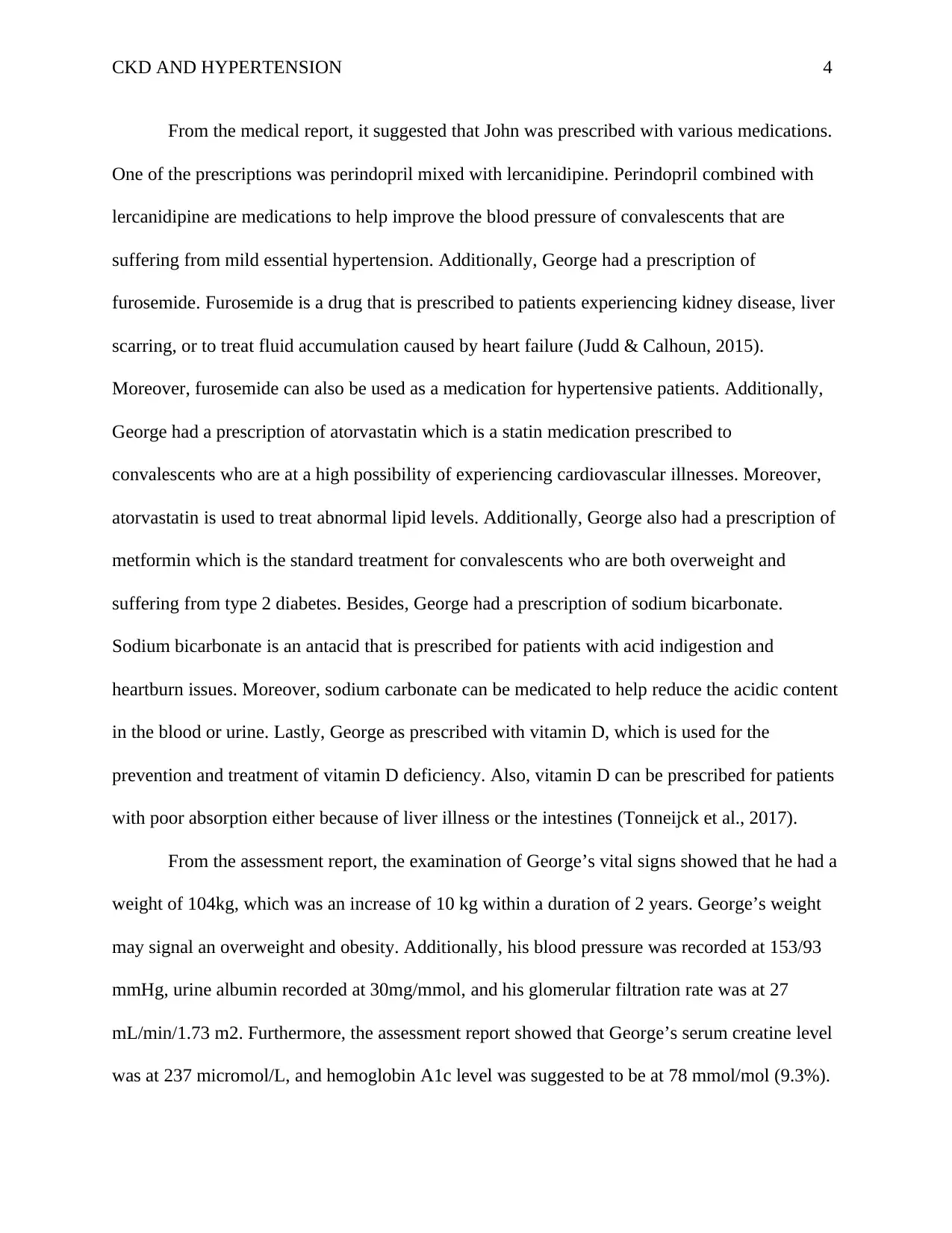
CKD AND HYPERTENSION 4
From the medical report, it suggested that John was prescribed with various medications.
One of the prescriptions was perindopril mixed with lercanidipine. Perindopril combined with
lercanidipine are medications to help improve the blood pressure of convalescents that are
suffering from mild essential hypertension. Additionally, George had a prescription of
furosemide. Furosemide is a drug that is prescribed to patients experiencing kidney disease, liver
scarring, or to treat fluid accumulation caused by heart failure (Judd & Calhoun, 2015).
Moreover, furosemide can also be used as a medication for hypertensive patients. Additionally,
George had a prescription of atorvastatin which is a statin medication prescribed to
convalescents who are at a high possibility of experiencing cardiovascular illnesses. Moreover,
atorvastatin is used to treat abnormal lipid levels. Additionally, George also had a prescription of
metformin which is the standard treatment for convalescents who are both overweight and
suffering from type 2 diabetes. Besides, George had a prescription of sodium bicarbonate.
Sodium bicarbonate is an antacid that is prescribed for patients with acid indigestion and
heartburn issues. Moreover, sodium carbonate can be medicated to help reduce the acidic content
in the blood or urine. Lastly, George as prescribed with vitamin D, which is used for the
prevention and treatment of vitamin D deficiency. Also, vitamin D can be prescribed for patients
with poor absorption either because of liver illness or the intestines (Tonneijck et al., 2017).
From the assessment report, the examination of George’s vital signs showed that he had a
weight of 104kg, which was an increase of 10 kg within a duration of 2 years. George’s weight
may signal an overweight and obesity. Additionally, his blood pressure was recorded at 153/93
mmHg, urine albumin recorded at 30mg/mmol, and his glomerular filtration rate was at 27
mL/min/1.73 m2. Furthermore, the assessment report showed that George’s serum creatine level
was at 237 micromol/L, and hemoglobin A1c level was suggested to be at 78 mmol/mol (9.3%).
From the medical report, it suggested that John was prescribed with various medications.
One of the prescriptions was perindopril mixed with lercanidipine. Perindopril combined with
lercanidipine are medications to help improve the blood pressure of convalescents that are
suffering from mild essential hypertension. Additionally, George had a prescription of
furosemide. Furosemide is a drug that is prescribed to patients experiencing kidney disease, liver
scarring, or to treat fluid accumulation caused by heart failure (Judd & Calhoun, 2015).
Moreover, furosemide can also be used as a medication for hypertensive patients. Additionally,
George had a prescription of atorvastatin which is a statin medication prescribed to
convalescents who are at a high possibility of experiencing cardiovascular illnesses. Moreover,
atorvastatin is used to treat abnormal lipid levels. Additionally, George also had a prescription of
metformin which is the standard treatment for convalescents who are both overweight and
suffering from type 2 diabetes. Besides, George had a prescription of sodium bicarbonate.
Sodium bicarbonate is an antacid that is prescribed for patients with acid indigestion and
heartburn issues. Moreover, sodium carbonate can be medicated to help reduce the acidic content
in the blood or urine. Lastly, George as prescribed with vitamin D, which is used for the
prevention and treatment of vitamin D deficiency. Also, vitamin D can be prescribed for patients
with poor absorption either because of liver illness or the intestines (Tonneijck et al., 2017).
From the assessment report, the examination of George’s vital signs showed that he had a
weight of 104kg, which was an increase of 10 kg within a duration of 2 years. George’s weight
may signal an overweight and obesity. Additionally, his blood pressure was recorded at 153/93
mmHg, urine albumin recorded at 30mg/mmol, and his glomerular filtration rate was at 27
mL/min/1.73 m2. Furthermore, the assessment report showed that George’s serum creatine level
was at 237 micromol/L, and hemoglobin A1c level was suggested to be at 78 mmol/mol (9.3%).
Paraphrase This Document
Need a fresh take? Get an instant paraphrase of this document with our AI Paraphraser
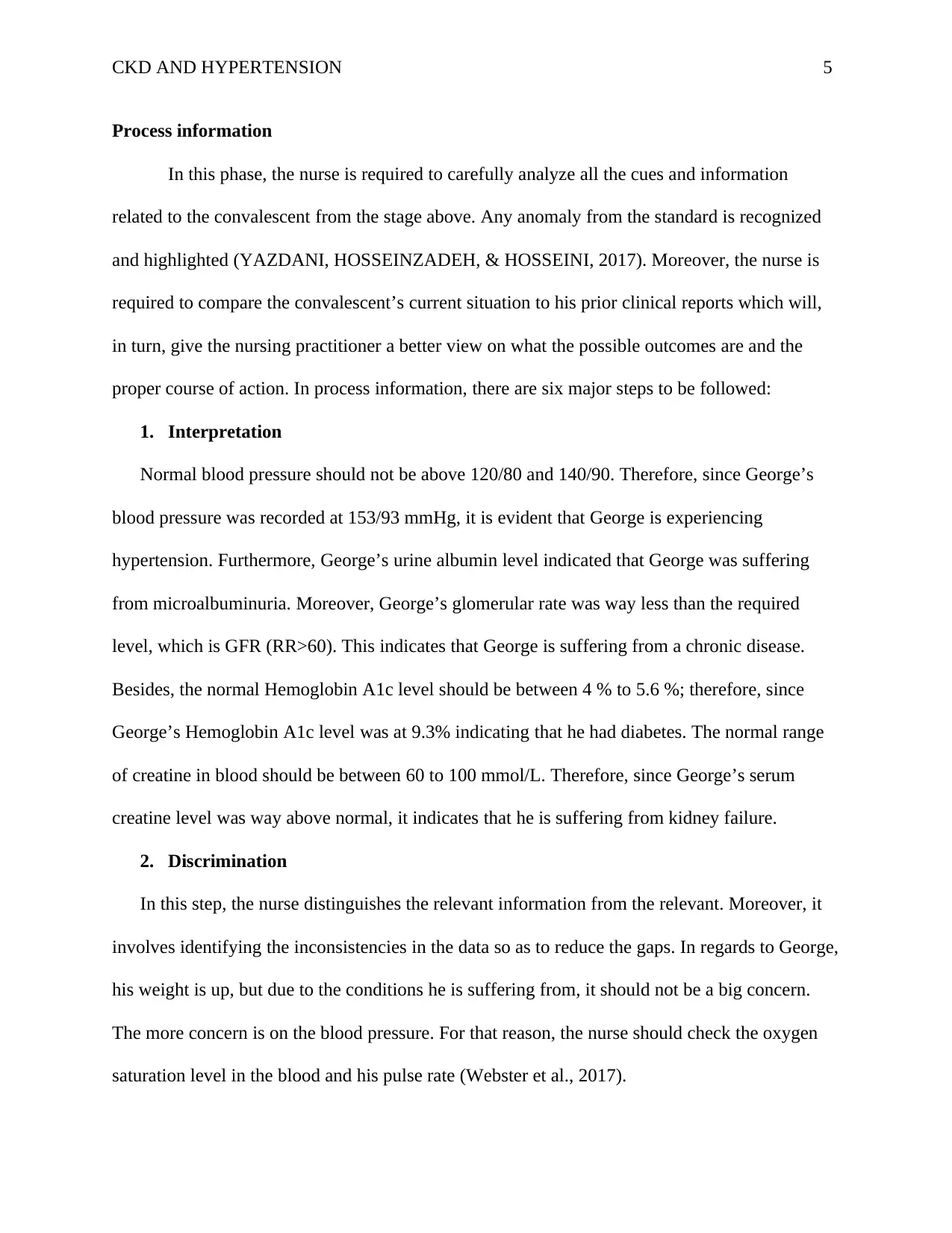
CKD AND HYPERTENSION 5
Process information
In this phase, the nurse is required to carefully analyze all the cues and information
related to the convalescent from the stage above. Any anomaly from the standard is recognized
and highlighted (YAZDANI, HOSSEINZADEH, & HOSSEINI, 2017). Moreover, the nurse is
required to compare the convalescent’s current situation to his prior clinical reports which will,
in turn, give the nursing practitioner a better view on what the possible outcomes are and the
proper course of action. In process information, there are six major steps to be followed:
1. Interpretation
Normal blood pressure should not be above 120/80 and 140/90. Therefore, since George’s
blood pressure was recorded at 153/93 mmHg, it is evident that George is experiencing
hypertension. Furthermore, George’s urine albumin level indicated that George was suffering
from microalbuminuria. Moreover, George’s glomerular rate was way less than the required
level, which is GFR (RR>60). This indicates that George is suffering from a chronic disease.
Besides, the normal Hemoglobin A1c level should be between 4 % to 5.6 %; therefore, since
George’s Hemoglobin A1c level was at 9.3% indicating that he had diabetes. The normal range
of creatine in blood should be between 60 to 100 mmol/L. Therefore, since George’s serum
creatine level was way above normal, it indicates that he is suffering from kidney failure.
2. Discrimination
In this step, the nurse distinguishes the relevant information from the relevant. Moreover, it
involves identifying the inconsistencies in the data so as to reduce the gaps. In regards to George,
his weight is up, but due to the conditions he is suffering from, it should not be a big concern.
The more concern is on the blood pressure. For that reason, the nurse should check the oxygen
saturation level in the blood and his pulse rate (Webster et al., 2017).
Process information
In this phase, the nurse is required to carefully analyze all the cues and information
related to the convalescent from the stage above. Any anomaly from the standard is recognized
and highlighted (YAZDANI, HOSSEINZADEH, & HOSSEINI, 2017). Moreover, the nurse is
required to compare the convalescent’s current situation to his prior clinical reports which will,
in turn, give the nursing practitioner a better view on what the possible outcomes are and the
proper course of action. In process information, there are six major steps to be followed:
1. Interpretation
Normal blood pressure should not be above 120/80 and 140/90. Therefore, since George’s
blood pressure was recorded at 153/93 mmHg, it is evident that George is experiencing
hypertension. Furthermore, George’s urine albumin level indicated that George was suffering
from microalbuminuria. Moreover, George’s glomerular rate was way less than the required
level, which is GFR (RR>60). This indicates that George is suffering from a chronic disease.
Besides, the normal Hemoglobin A1c level should be between 4 % to 5.6 %; therefore, since
George’s Hemoglobin A1c level was at 9.3% indicating that he had diabetes. The normal range
of creatine in blood should be between 60 to 100 mmol/L. Therefore, since George’s serum
creatine level was way above normal, it indicates that he is suffering from kidney failure.
2. Discrimination
In this step, the nurse distinguishes the relevant information from the relevant. Moreover, it
involves identifying the inconsistencies in the data so as to reduce the gaps. In regards to George,
his weight is up, but due to the conditions he is suffering from, it should not be a big concern.
The more concern is on the blood pressure. For that reason, the nurse should check the oxygen
saturation level in the blood and his pulse rate (Webster et al., 2017).
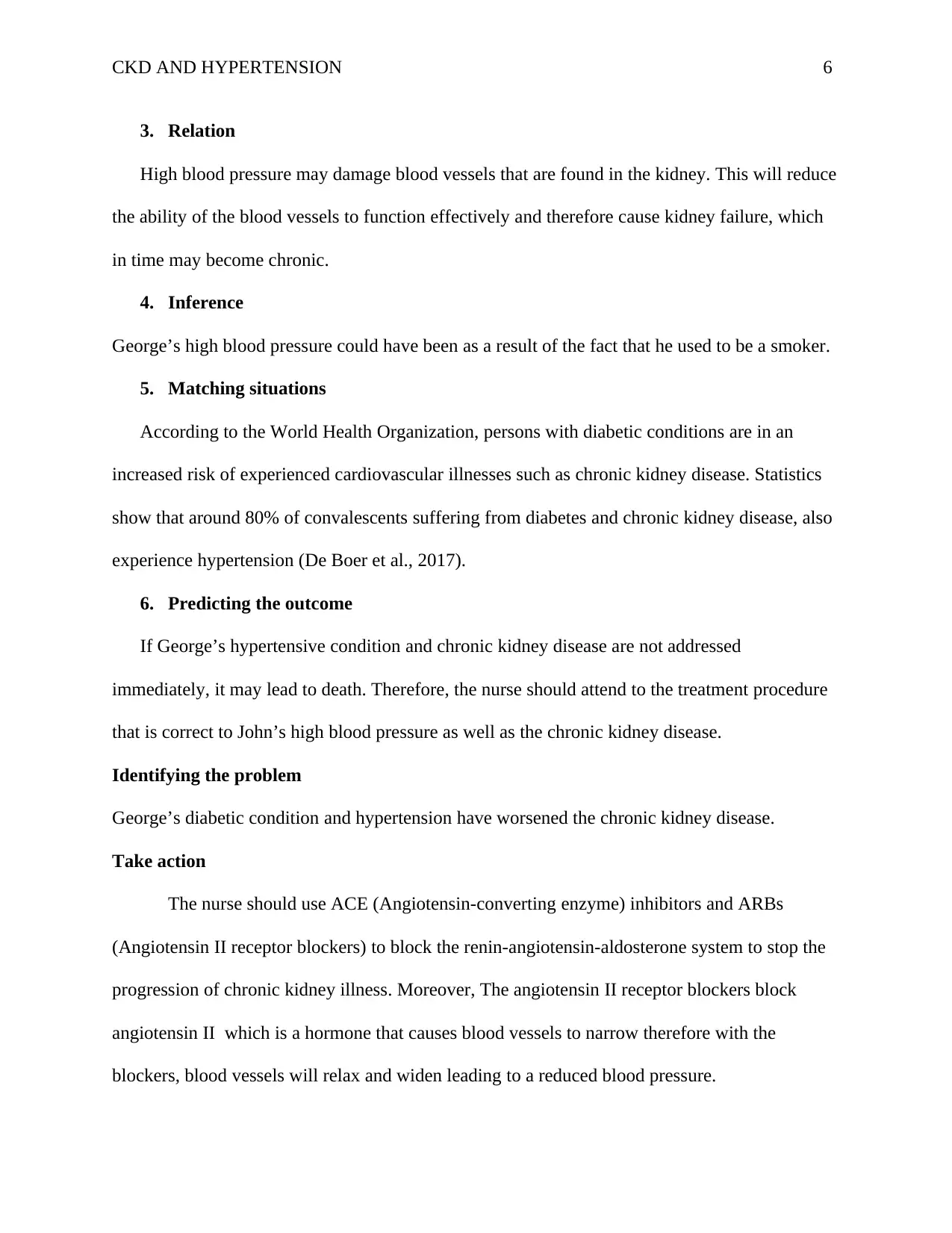
CKD AND HYPERTENSION 6
3. Relation
High blood pressure may damage blood vessels that are found in the kidney. This will reduce
the ability of the blood vessels to function effectively and therefore cause kidney failure, which
in time may become chronic.
4. Inference
George’s high blood pressure could have been as a result of the fact that he used to be a smoker.
5. Matching situations
According to the World Health Organization, persons with diabetic conditions are in an
increased risk of experienced cardiovascular illnesses such as chronic kidney disease. Statistics
show that around 80% of convalescents suffering from diabetes and chronic kidney disease, also
experience hypertension (De Boer et al., 2017).
6. Predicting the outcome
If George’s hypertensive condition and chronic kidney disease are not addressed
immediately, it may lead to death. Therefore, the nurse should attend to the treatment procedure
that is correct to John’s high blood pressure as well as the chronic kidney disease.
Identifying the problem
George’s diabetic condition and hypertension have worsened the chronic kidney disease.
Take action
The nurse should use ACE (Angiotensin-converting enzyme) inhibitors and ARBs
(Angiotensin II receptor blockers) to block the renin-angiotensin-aldosterone system to stop the
progression of chronic kidney illness. Moreover, The angiotensin II receptor blockers block
angiotensin II which is a hormone that causes blood vessels to narrow therefore with the
blockers, blood vessels will relax and widen leading to a reduced blood pressure.
3. Relation
High blood pressure may damage blood vessels that are found in the kidney. This will reduce
the ability of the blood vessels to function effectively and therefore cause kidney failure, which
in time may become chronic.
4. Inference
George’s high blood pressure could have been as a result of the fact that he used to be a smoker.
5. Matching situations
According to the World Health Organization, persons with diabetic conditions are in an
increased risk of experienced cardiovascular illnesses such as chronic kidney disease. Statistics
show that around 80% of convalescents suffering from diabetes and chronic kidney disease, also
experience hypertension (De Boer et al., 2017).
6. Predicting the outcome
If George’s hypertensive condition and chronic kidney disease are not addressed
immediately, it may lead to death. Therefore, the nurse should attend to the treatment procedure
that is correct to John’s high blood pressure as well as the chronic kidney disease.
Identifying the problem
George’s diabetic condition and hypertension have worsened the chronic kidney disease.
Take action
The nurse should use ACE (Angiotensin-converting enzyme) inhibitors and ARBs
(Angiotensin II receptor blockers) to block the renin-angiotensin-aldosterone system to stop the
progression of chronic kidney illness. Moreover, The angiotensin II receptor blockers block
angiotensin II which is a hormone that causes blood vessels to narrow therefore with the
blockers, blood vessels will relax and widen leading to a reduced blood pressure.
⊘ This is a preview!⊘
Do you want full access?
Subscribe today to unlock all pages.

Trusted by 1+ million students worldwide
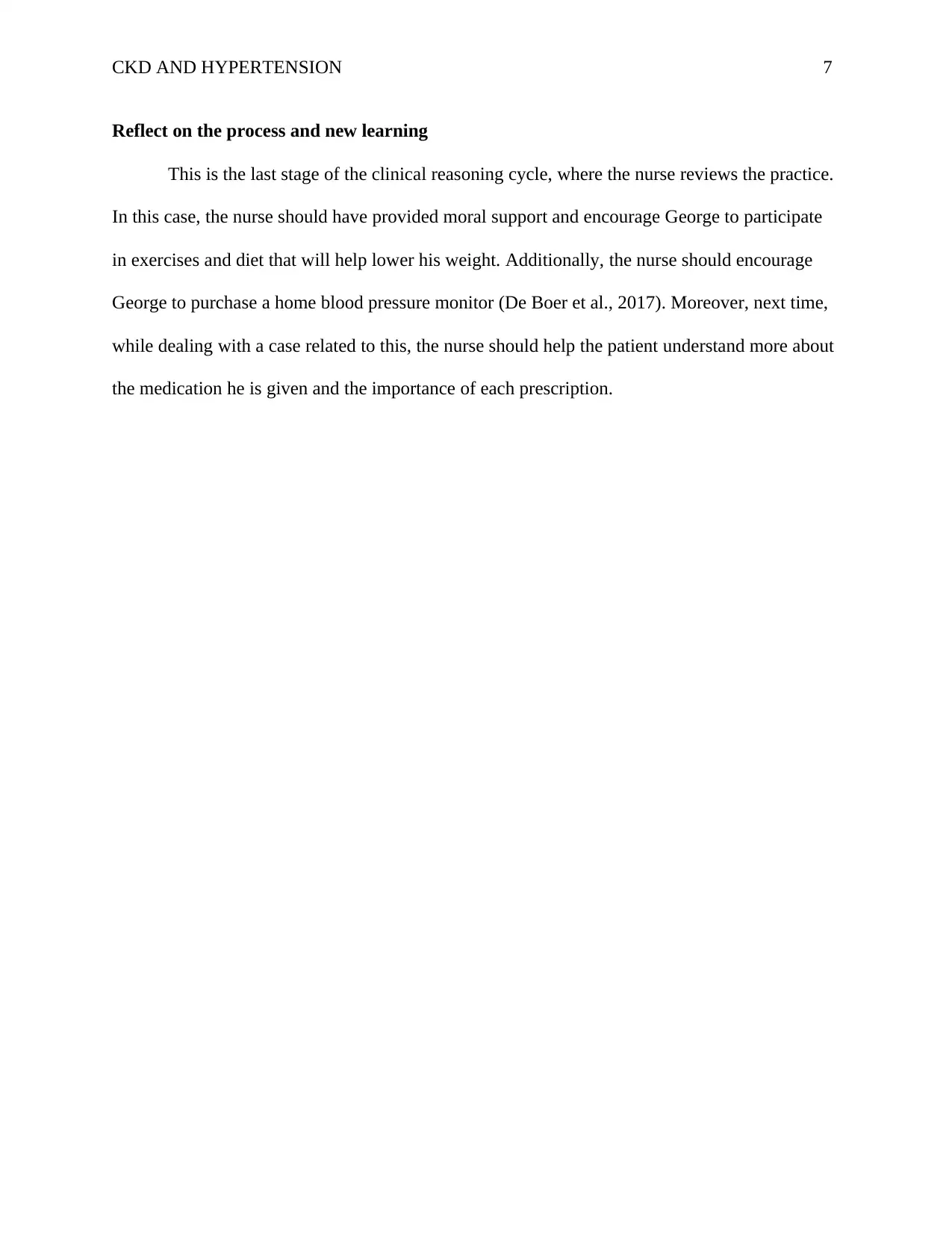
CKD AND HYPERTENSION 7
Reflect on the process and new learning
This is the last stage of the clinical reasoning cycle, where the nurse reviews the practice.
In this case, the nurse should have provided moral support and encourage George to participate
in exercises and diet that will help lower his weight. Additionally, the nurse should encourage
George to purchase a home blood pressure monitor (De Boer et al., 2017). Moreover, next time,
while dealing with a case related to this, the nurse should help the patient understand more about
the medication he is given and the importance of each prescription.
Reflect on the process and new learning
This is the last stage of the clinical reasoning cycle, where the nurse reviews the practice.
In this case, the nurse should have provided moral support and encourage George to participate
in exercises and diet that will help lower his weight. Additionally, the nurse should encourage
George to purchase a home blood pressure monitor (De Boer et al., 2017). Moreover, next time,
while dealing with a case related to this, the nurse should help the patient understand more about
the medication he is given and the importance of each prescription.
Paraphrase This Document
Need a fresh take? Get an instant paraphrase of this document with our AI Paraphraser
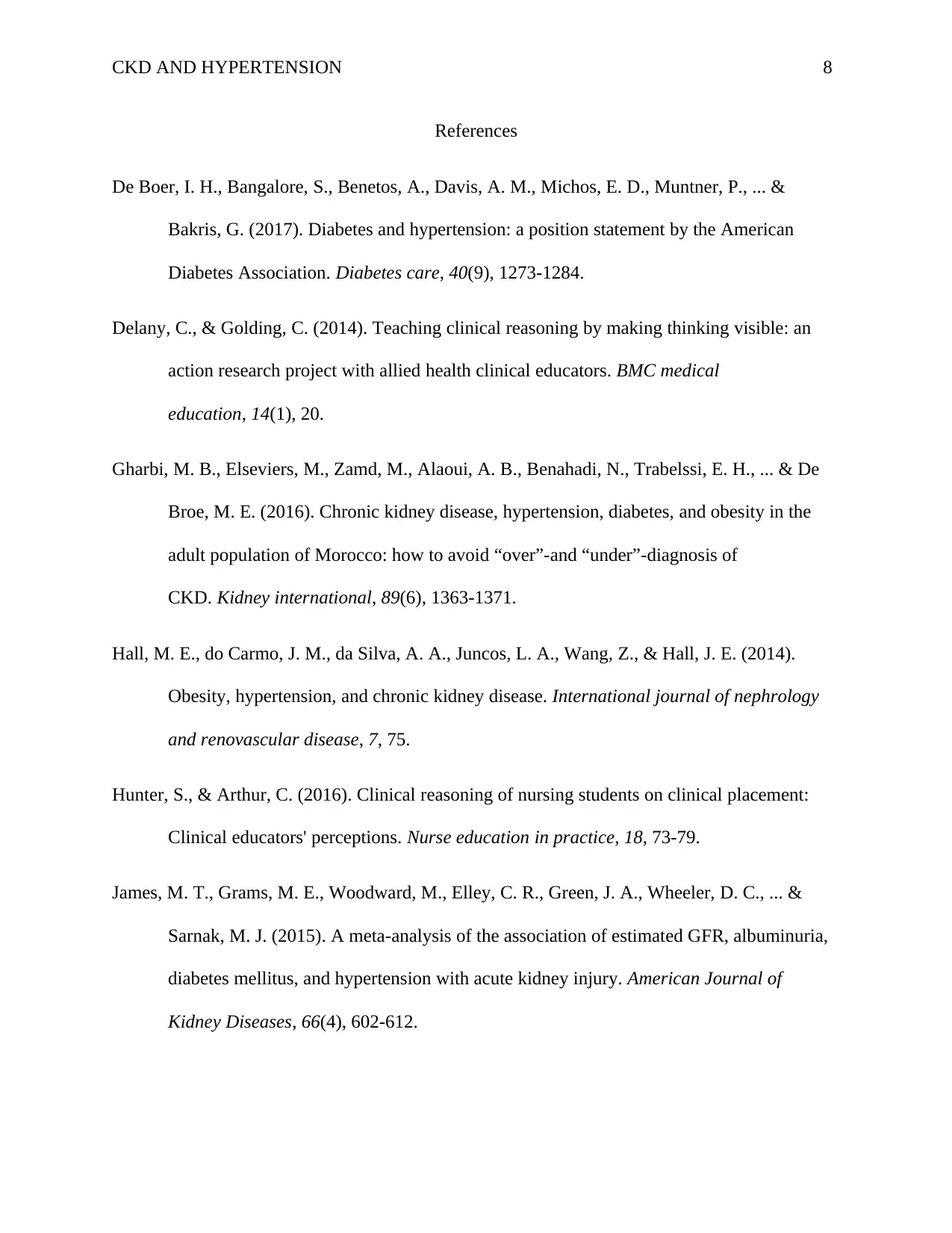
CKD AND HYPERTENSION 8
References
De Boer, I. H., Bangalore, S., Benetos, A., Davis, A. M., Michos, E. D., Muntner, P., ... &
Bakris, G. (2017). Diabetes and hypertension: a position statement by the American
Diabetes Association. Diabetes care, 40(9), 1273-1284.
Delany, C., & Golding, C. (2014). Teaching clinical reasoning by making thinking visible: an
action research project with allied health clinical educators. BMC medical
education, 14(1), 20.
Gharbi, M. B., Elseviers, M., Zamd, M., Alaoui, A. B., Benahadi, N., Trabelssi, E. H., ... & De
Broe, M. E. (2016). Chronic kidney disease, hypertension, diabetes, and obesity in the
adult population of Morocco: how to avoid “over”-and “under”-diagnosis of
CKD. Kidney international, 89(6), 1363-1371.
Hall, M. E., do Carmo, J. M., da Silva, A. A., Juncos, L. A., Wang, Z., & Hall, J. E. (2014).
Obesity, hypertension, and chronic kidney disease. International journal of nephrology
and renovascular disease, 7, 75.
Hunter, S., & Arthur, C. (2016). Clinical reasoning of nursing students on clinical placement:
Clinical educators' perceptions. Nurse education in practice, 18, 73-79.
James, M. T., Grams, M. E., Woodward, M., Elley, C. R., Green, J. A., Wheeler, D. C., ... &
Sarnak, M. J. (2015). A meta-analysis of the association of estimated GFR, albuminuria,
diabetes mellitus, and hypertension with acute kidney injury. American Journal of
Kidney Diseases, 66(4), 602-612.
References
De Boer, I. H., Bangalore, S., Benetos, A., Davis, A. M., Michos, E. D., Muntner, P., ... &
Bakris, G. (2017). Diabetes and hypertension: a position statement by the American
Diabetes Association. Diabetes care, 40(9), 1273-1284.
Delany, C., & Golding, C. (2014). Teaching clinical reasoning by making thinking visible: an
action research project with allied health clinical educators. BMC medical
education, 14(1), 20.
Gharbi, M. B., Elseviers, M., Zamd, M., Alaoui, A. B., Benahadi, N., Trabelssi, E. H., ... & De
Broe, M. E. (2016). Chronic kidney disease, hypertension, diabetes, and obesity in the
adult population of Morocco: how to avoid “over”-and “under”-diagnosis of
CKD. Kidney international, 89(6), 1363-1371.
Hall, M. E., do Carmo, J. M., da Silva, A. A., Juncos, L. A., Wang, Z., & Hall, J. E. (2014).
Obesity, hypertension, and chronic kidney disease. International journal of nephrology
and renovascular disease, 7, 75.
Hunter, S., & Arthur, C. (2016). Clinical reasoning of nursing students on clinical placement:
Clinical educators' perceptions. Nurse education in practice, 18, 73-79.
James, M. T., Grams, M. E., Woodward, M., Elley, C. R., Green, J. A., Wheeler, D. C., ... &
Sarnak, M. J. (2015). A meta-analysis of the association of estimated GFR, albuminuria,
diabetes mellitus, and hypertension with acute kidney injury. American Journal of
Kidney Diseases, 66(4), 602-612.
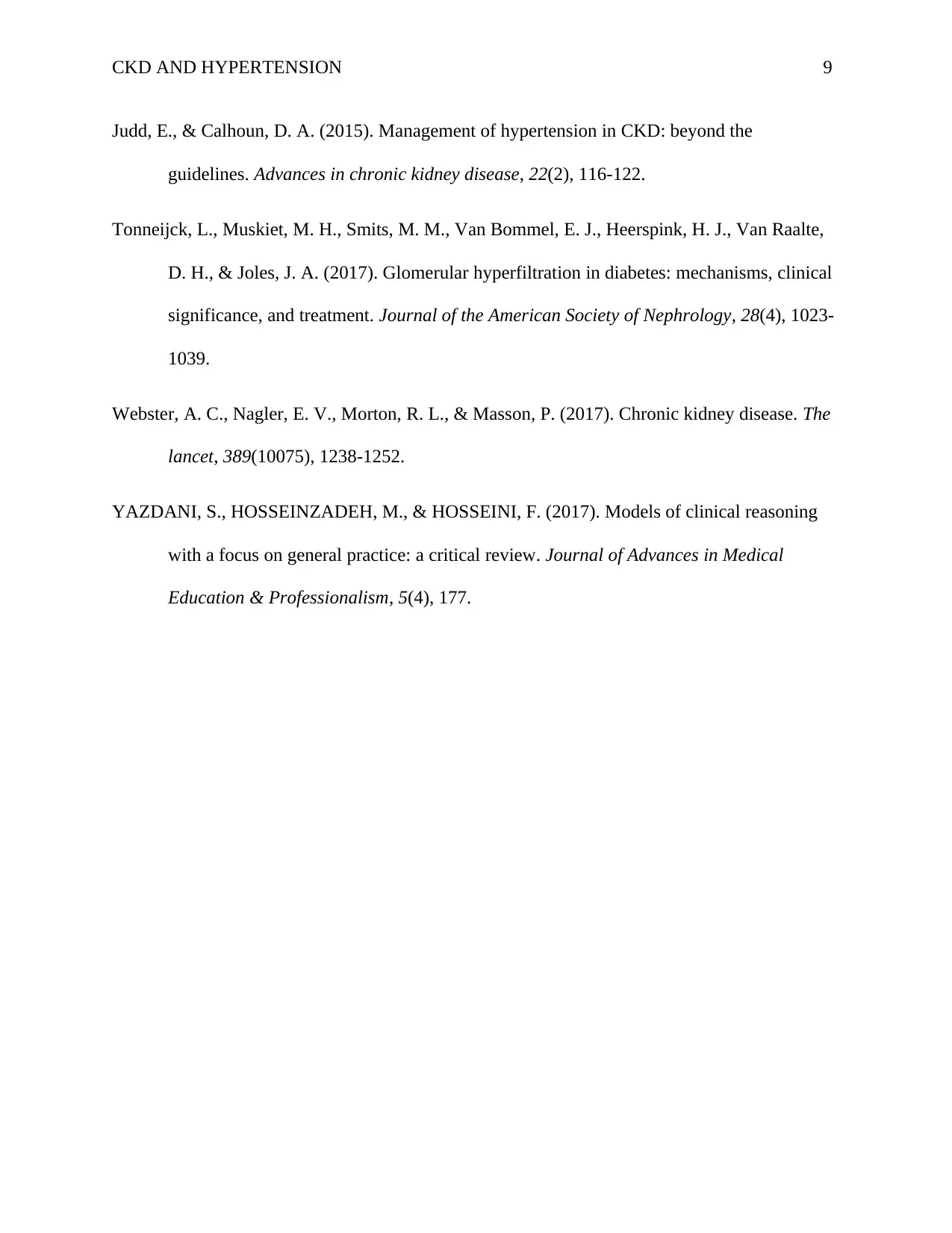
CKD AND HYPERTENSION 9
Judd, E., & Calhoun, D. A. (2015). Management of hypertension in CKD: beyond the
guidelines. Advances in chronic kidney disease, 22(2), 116-122.
Tonneijck, L., Muskiet, M. H., Smits, M. M., Van Bommel, E. J., Heerspink, H. J., Van Raalte,
D. H., & Joles, J. A. (2017). Glomerular hyperfiltration in diabetes: mechanisms, clinical
significance, and treatment. Journal of the American Society of Nephrology, 28(4), 1023-
1039.
Webster, A. C., Nagler, E. V., Morton, R. L., & Masson, P. (2017). Chronic kidney disease. The
lancet, 389(10075), 1238-1252.
YAZDANI, S., HOSSEINZADEH, M., & HOSSEINI, F. (2017). Models of clinical reasoning
with a focus on general practice: a critical review. Journal of Advances in Medical
Education & Professionalism, 5(4), 177.
Judd, E., & Calhoun, D. A. (2015). Management of hypertension in CKD: beyond the
guidelines. Advances in chronic kidney disease, 22(2), 116-122.
Tonneijck, L., Muskiet, M. H., Smits, M. M., Van Bommel, E. J., Heerspink, H. J., Van Raalte,
D. H., & Joles, J. A. (2017). Glomerular hyperfiltration in diabetes: mechanisms, clinical
significance, and treatment. Journal of the American Society of Nephrology, 28(4), 1023-
1039.
Webster, A. C., Nagler, E. V., Morton, R. L., & Masson, P. (2017). Chronic kidney disease. The
lancet, 389(10075), 1238-1252.
YAZDANI, S., HOSSEINZADEH, M., & HOSSEINI, F. (2017). Models of clinical reasoning
with a focus on general practice: a critical review. Journal of Advances in Medical
Education & Professionalism, 5(4), 177.
⊘ This is a preview!⊘
Do you want full access?
Subscribe today to unlock all pages.

Trusted by 1+ million students worldwide
1 out of 9
Related Documents
Your All-in-One AI-Powered Toolkit for Academic Success.
+13062052269
info@desklib.com
Available 24*7 on WhatsApp / Email
![[object Object]](/_next/static/media/star-bottom.7253800d.svg)
Unlock your academic potential
Copyright © 2020–2025 A2Z Services. All Rights Reserved. Developed and managed by ZUCOL.





